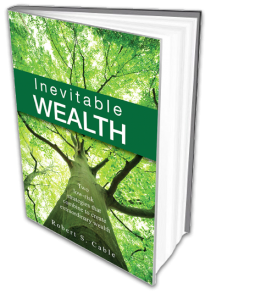 While stocks are viewed by most of the financial industry as the main ingredient for creating wealth, it’s well known that the price for higher expected returns is higher risk. The paradox is that in order to increase the odds of creating greater wealth, you have to be willing to lose some wealth at least in the short term.
While stocks are viewed by most of the financial industry as the main ingredient for creating wealth, it’s well known that the price for higher expected returns is higher risk. The paradox is that in order to increase the odds of creating greater wealth, you have to be willing to lose some wealth at least in the short term.
All of which makes Robert S. Cable’s newly published book (his second) of more than theoretical interest. Inevitable Wealth bears the subtitle Two low-risk strategies that combine to create extraordinary wealth.
We have touched on this book and its belief in the long-term power of equities in a recent review I did at the Financial Post, where I compared Inevitable Wealth to David Trahair’s Enough Bull. You can also find guest blogs by both authors here at the Hub, where the pair make the cases for mostly stocks in the first case, and mostly fixed income (i.e. GICs) in the second.
I had read both books earlier in the summer, well before the extreme market volatility of late August. Ironically, both books would have helped you preserve capital, depending on how you implemented the suggestions: Trahair famously counsels being 100% in GICs (the equivalent of CDs or Certificates of Deposit in the United States). While Cable is a big believer in stocks for the long run he also has a healthy respect for protecting the downside of stocks — so much so that the second of his advertised “low-risk” strategies is a version of the old investing saw Sell in May and Go Away.
Seasonal investing lowers risk

Cable — who heads ScotiaMcLeod’s Cable Group in Mississauga — offers clients a “seasonal investing” option that essentially dials back risk in the summer months. Cable begins that section of the book with a tongue-in-cheek chapter title: “Everyone knows that market timing doesn’t work,” in which he makes his case for seasonal investing.
Understand that any good market-timing strategy is about risk reduction, not risk elimination.
Cable concedes that most market timers do poorly, mostly because when they’re under pressure they allow their emotions to dictate their decisions, “and we know that an emotional response in investing is almost always a costly one.”
He allows that this argument is often used by the “you can’t time the market” proponents and that this can be valid: “If you’re the type of investor who is driven to act emotionally, then a buy-and-hold strategy is the answer for you. Ignore the market.”
Few buy-and-holders succeed in ignoring the market
Unfortunately, this is more easily said than done. Most investors are not able to buy and hold forever while ignoring the market. Enter Cable’s approach to market timing, which he describes as a “discipline that moves you out of the market during higher-risk periods and back in when risk is statistically much lower.” But again, such an approach will fail if it’s based on emotion, which is why to succeed it must be a mechanical data-driven one.
Cable then devotes a chapter to American Market Seasonality, and comes to the following conclusion:
Research has proven conclusively that over very long periods of time, the six-month period from November through April produces stock market returns that are well above average. Conversely, the six months beginning in May and lasting through October have produced well-below-average returns.
Cable’s data shows that November-April’s returns over 64 years going back to 1950 were an astounding 100 times the return of May-October.
In theory then, Cable’s clients would buy on November 1st of each year and sell on April 30th of the following year, but in practice, Cable closely watch various market parameters and tweaks the actual entry and exit of markets. He also has one set of signals and decisions for the Canadian market, in addition to the one for the U.S. one. But after investors experienced the August we just experienced, it’s no surprise that Cable writes “August and September are, historically, two of the worst months of the year.”
It’s a book that’s well worth reading and possibly acting on, if it’s not already too late.
Bob’s comments from Aug 21 and Aug 31
Here’s some of an email Bob sent me as markets started to crack on August 21st, and below it one from yesterday, Aug 31st:
Every few years it happens … I get a handful of clients questioning whether there’s really any need to exit the market in May or June or whenever we get the signal that indicates that the risk of staying in the market just isn’t worth it. This always happens after a few good market years when people didn’t gain anything by exiting and they’ve forgotten that they dodged a huge bullet in 2008 when some of the investments we sold dropped north of 50%. It’s human nature to look at recent history while ignoring all history. Or your own experience rather than the long-term data.When I see this kind of complacency or even a few saying they want to ignore the signal and stay invested, I can tell we’re likely getting close to one of those May-October’s that remind people that the market is not a one-way street.This might just be one of those years. I’m not 100% cash. Never am. My dividend-growth stocks like ENB can’t entirely fight off the selling. But my seasonal is 100% cash and I suspect when that money is re-employed, it will be at better levels than where we exited, probably around the time when many “I can’t take the pain anymore towels are being thrown in.”I think this strategy will still benefit people until everyone becomes believers in it and as you know, we are a very long way from that happening.
I’m fairly certain most people relate to the dividend/dividend growth strategy outlined in my book and very few believe in market timing. It’s just the way it is. One is easy to believe in and there are probably 100 articles recommending it for every one that recommends market timing. In fact I’d guess there are way more articles written saying that only idiots try to time the market vs. ones that recommend it. I’m quite content to use both strategies and like the lower risk/higher reward that both, at least historically, have offered.


I was duped by a fraudulent cryptocurrency platform that seemed legitimate at first. After paying, they repeatedly asked for more money. When I suspected foul play and requested a refund, they locked me out of my account and ignored my emails. Luckily, I found the Ultimate Recovery Firm, a group of expert cryptographers and hackers. They helped me recover my stolen funds and exposed the scammers. I’m grateful for their assistance.
If you’ve fallen victim to a similar scam, don’t hesitate to reach out to the Ultimate Recovery Team:
Email: ultimaterecoveryfirm>>@>>gmail.>>com